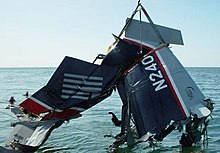Colgan Air Flight 9446
| Colgan Air Flight 9446 | |
|---|---|
|
An identical Beechcraft 1900D from Colgan Air in the livery of US Airways Express |
|
| Accident summary | |
| Accident type | Loss of control |
| place |
Atlantic Ocean , at Hyannis , Massachusetts , United States |
| date | August 26, 2003 |
| Fatalities | 2 |
| Survivors | 0 |
| Aircraft | |
| Aircraft type |
|
| operator |
|
| Mark |
|
| Departure airport |
Barnstable Municipal Airport , Yarmouth , Massachusetts , United States |
| Destination airport |
Albany International Airport , Albany , New York United States |
| Passengers | 0 |
| crew | 2 |
| Lists of aviation accidents | |
On August 26, 2003, on Colgan Air Flight 9446 , a Beechcraft 1900D , operated by Colgan Air for US Airways Express , crashed into the Atlantic Ocean near Hyannis , Massachusetts . Both pilots were killed on board the machine in the accident. The crash was caused by gross maintenance errors.
machine
The affected machine was a Beechcraft 1900D. The machine was finally assembled in 1993 and had the factory number UE-40. The machine was delivered new to Commutair in March 1993 with the aircraft registration number N841CA , which operated flights on behalf of USAir Express. In August 2000, Commutair registered the aircraft under the aircraft registration number N84102 . On October 10, 2000, Colgan Air took over the machine and registered it with the last registration number N240CJ . The twin-engine regional airliner was equipped with two Pratt & Whitney Canada PT6A-67D turboprop engines . By the time of the accident, the machine had completed a total operating performance of 16,503 operating hours, which accounted for 24,637 take-offs and landings.
Inmates and flight plan
After a major maintenance was carried out on the machine at Barnstable Municipal Airport , it was to be transferred to Albany International Airport , with the flight being a test and positioning flight at the same time. There was only a two-person crew on board the machine, consisting of the flight captain Scott Knabe and the first officer Steven Dean.
prehistory
On August 23, 2003, the Beechcraft 1900D N240CJ underwent a detailed six-phase maintenance inspection of the rear fuselage and tail unit. The examination phase was suspended and the remaining work was postponed on the morning of August 24th. Ten routes were flown that day and work resumed on the evening of August 24th and completed on August 26th. During the maintenance work, the two servomotors for elevator trim were replaced. During this process, the manufacturer's maintenance instructions were not followed exactly and the cable for operating these Flettner oars was unwound from the front drum. The front cable of the Flettner rudder was then replaced. During the replacement of the cable, the maintenance staff overlooked a point in the maintenance manual. It did not use a guide wire for orientation when laying the cables. In addition, the drum of the trim cable was incorrectly shown in the maintenance instructions and the cable routing was not clearly shown.
the accident
The plane took off from Barnstable Municipal Airport at 3:40 p.m. local time. Shortly after take-off, the pilots declared an air emergency and reported a problem with the trim of the machine. They made a left turn with the machine and reached an altitude of 1,100 feet. They then asked permission to return to Barnstable Airport and air traffic control immediately gave clearance. The machine turned with the nose of the aircraft pointing upwards, then nodded down and crashed into the sea near the airport, near Hyannis, Massachusetts, off the coast. In the accident, the machine was destroyed and both pilots were killed.
root cause
The National Transportation Safety Board investigated the accident. Investigators concluded that the elevator control cables had been installed upside down during maintenance. As a result, the trim system was configured in such a way that when the electrical trim was operated, the Flettner rudders of the trim moved in the correct direction, but the trim wheel in the cockpit moved in the opposite direction. Likewise, when the manual trim wheel was operated, the Flettner oars (trim tabs) moved in the opposite direction.
The NTSB also found that the pilots did not notice the maintenance error because the master had not gone through the checklist prior to take-off, which included a review of the elevator trim. Pilots manually adjusted the trim prior to departure, but due to improper maintenance, the trim tabs were actually adjusted so that the aircraft nose was fully down for flight. Investigators found that the pilots would have had to apply 250 pounds of force on the control column to keep the machine in the air. A safe landing was almost impossible under these conditions. The investigators programmed a flight simulator with the wrong trim settings and simulated the flight six times. Five attempts led to crashes shortly after take-off, in one attempt the pilot was able to circle the curve for a landing, but the machine flew into the ground when attempting to land.
Individual evidence
- ↑ a b c d e f Incident Report , National Transportation Safety Board
- ↑ Operating history of the machine on rzjets.net
- ↑ a b c d Accident report 1900D, N240CJ in the Aviation Safety Network
- ↑ a b c d e Crossed Cables: Colgan Air B1900D N240CJ Maintenance Error , aerossurance.com
- ↑ a b c NTSB Identification: NYC03MA183 , National Transportation Safety Board
Coordinates: 41 ° 37 ′ 0 ″ N , 70 ° 15 ′ 0 ″ W.

